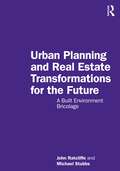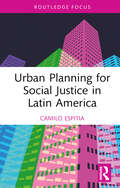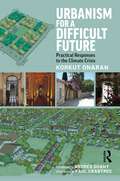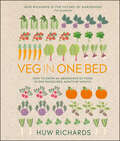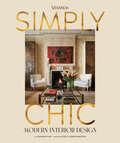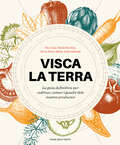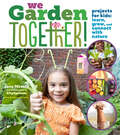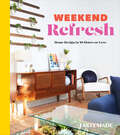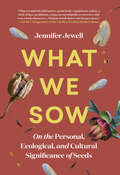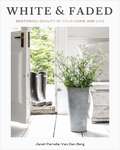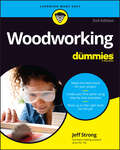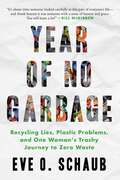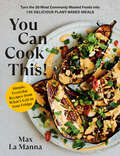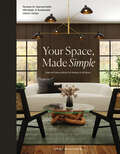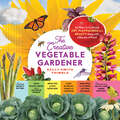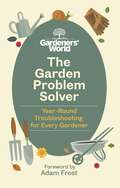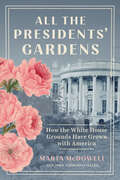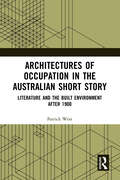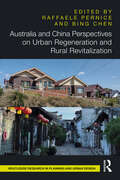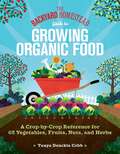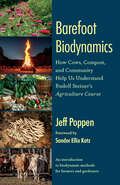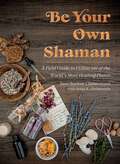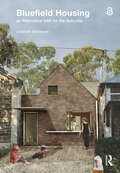- Table View
- List View
Urban Planning and Real Estate Transformations for the Future: A Built Environment Bricolage
by John Ratcliffe Michael StubbsThis book presents fresh ways of thinking about the future for all those involved in conceiving, planning, designing, funding, constructing, occupying and managing the built environment, to face the challenges, and grasp the opportunities, that lie ahead over the next few decades. Four major themes form the basis of the volume: (1) Future Awareness and a New Sense of Place. (2) Global Governance and Anticipatory Leadership. (3) Innovation, Reform and Exemplars. (4) Urban Planning and Real Estate Transformations. Within these structural themes are a diverse range of 'Discourses' addressing many of the big questions and driving forces that face us, together with a proposed methodology (Strategic Foresight) and an array of practical illustrations viewing what can be done today – whether by organisations, individuals, cities or communities – to positively shape a preferred future and manipulate us towards achieving it. It will be important reading for students, practitioners, agencies and corporations across the built environment, especially in the fields of urban planning, real estate development, architecture, civil engineering and construction.
Urban Planning and Real Estate Transformations for the Future: A Built Environment Bricolage
by John Ratcliffe Michael StubbsThis book presents fresh ways of thinking about the future for all those involved in conceiving, planning, designing, funding, constructing, occupying and managing the built environment, to face the challenges, and grasp the opportunities, that lie ahead over the next few decades. Four major themes form the basis of the volume:(1) Future Awareness and a New Sense of Place.(2) Global Governance and Anticipatory Leadership. (3) Innovation, Reform and Exemplars. (4) Urban Planning and Real Estate Transformations. Within these structural themes are a diverse range of 'Discourses' addressing many of the big questions and driving forces that face us, together with a proposed methodology (Strategic Foresight) and an array of practical illustrations viewing what can be done today – whether by organisations, individuals, cities or communities – to positively shape a preferred future and manipulate us towards achieving it. It will be important reading for students, practitioners, agencies and corporations across the built environment, especially in the fields of urban planning, real estate development, architecture, civil engineering and construction.
Urban Planning for Social Justice in Latin America
by Camilo EspitiaUrban Planning for Social Justice in Latin America explores how urban planning can be used as a tool for social equity. The book examines several Latin American cities, each with specific challenges, and explores how they have gradually overcome these difficulties through policies, planning, and design, and with private/public sector coordination. The cases include: The built environment and social mobility in Bogotá; Mexico City and its difficulties with water scarcity; Addressing air quality and environmental justice in Lima; Santiago de Chile’s energy consumption and carbon footprint; Buenos Aires and the issue of urban agriculture and food security; Connectivity as a social transformation device in Medellín. The book goes beyond simply identifying the challenges and explains some of the practical day-to-day planning efforts, including interviews with staff from those municipalities, illustrations, and strategies that have been successful. As a result, this book will be helpful to planners in the region, as well as outside Latin America, because it demonstrates how fruitful results can be achieved in areas typically perceived as underdeveloped. Although based on research and data, this book offers a positive perspective on the possibilities rather than the limitations, hoping to inspire new generations of planners to pursue careers in search of social change.
Urbanism for a Difficult Future: Practical Responses to the Climate Crisis
by Korkut OnaranUrbanism for a Difficult Future: Practical Responses to the Climate Crisis is a much-needed guide to launching the next generation of land use planning and urbanism that will enable us to adapt to and survive the consequences of climate change. The book offers strong, straightforward measures for creating a landscape of resilience via pockets of self-sufficiencies. It demonstrates how to secure systems that sustain life (energy, water, food, waste, and production of essential goods) as well as political and social protocols enabling agile decision-making in managing these systems effectively at local levels. It also provides the design principles for creating a built environment that will enable the kind of localization we need for adaptation. The book explores how it is possible to create a life that does not depend on large-scale regional sustenance systems which are likely to be disrupted or fail. This book uncovers how to enable people to be creative, productive, and supportive at local levels, so that we can achieve strong and diverse local economies that can sustain life. It will appeal to students, planners, and policy makers working in environmental studies, environmental engineering, urban and regional planning, architecture, landscape architecture, and urbanism.
Veg in One Bed New Edition: How to Grow an Abundance of Food in One Raised Bed, Month by Month
by Huw RichardsGrow your own vegetable garden with this practical, straightforward gardening guide.There is nothing more fulfilling than growing your own home produce. You don't have to be a seasoned gardener to produce a healthy, flourishing garden - all you need is a few seeds, water, sunlight, good advice and patience!In just one raised bed, author Huw Richards, shows you exactly how to grow vegetables organically, abundantly and inexpensively so you have something to harvest every month of the year. Here's what you'll find inside:- Month-by-month guide to what to do and how to do it, including what pests to look out for, and what can be harvested. - Covers first year in detail, with the final chapter on &‘Next Steps&’ providing suggestions of what to do in years two and three.- Illustrations show you what the bed should look like month to month.- Windowsill planting ensures early success cultivating plants before they are transferred into the bed.- Maintenance sections ensure readers know how to keep their plants (and raised bed) healthy each month.- Includes instructions on assessing your site and building a 4x10ft (1.2x3m) raised bed.- Alternative vegetables are recommended, allowing readers to tailor their bed to their taste.- Plans chart growing season for different circumstances: cool climate, low rainfall, low effort, salad bed, winter bed, herbs and edible flowers.Month by month, discover what you need to do and how to do it. Try becoming more self-sufficient in your allotment, a small garden, or even on a roof terrace. Veg In One Bed shows you that you can have a small thriving garden and still be able to maintain it, yielding fresh vegetables all year round. Learn what to do each month on your windowsill, where you'll raise seedlings, and in your raised bed, where your plants will grow to maturity. Everything is explained in clear, illustrated steps: building your bed, growing from seed, planting, feeding, and harvesting.This gardening book not only guides you through the whole process of building your raised bed through to harvesting your vegetables but also provides sustainable gardening practices, which will resonate with all gardeners committed to protecting our planet. This makes for the perfect book for new gardeners who want to grow their own produce, as well as the new generation of gardeners who are seeking a gardening guru of their own age.Veg in One Bed goes beyond the inspiring demonstrations on his YouTube channel "Huw Richards - Grow Food Organically". In this book he organizes all his ideas and suggestions into a blueprint for growing your own vegetables month by month. Little growing experience? Only a small space? No matter - with Veg in One Bed, you can still eat food you have grown all through the year.
Veranda Simply Chic
by Stephanie HuntA lavish collection of 30 spectacular homes around the world that are the epitome of chic, including coastal escapes, country retreats, and dramatic city residences.Chic is sophistication and elegance, balance and ebullience. It is stylish and fashionable, but never trendy and never tries too hard. On this exclusive Veranda tour of stunning homes, the talented designers and architects offer palettes, patterns, and points of view that are utterly confident and breathtakingly inspiring. The book opens the curtains on a fresh world of design that&’s ready, once again, to receive visitors.Veranda Simply Chic is a celebration of interior design that is authentic, alluring, and always dazzling. The inviting homes share a common thread of understated elegance and elevated ease; they round out the architecture and setting in such a way that evokes harmony and delightful surprise, a sense of &“oh, I&’d like to spend time here.&”Chic design can be found all over the world, from San Miguel to Montreal, from Paris to Pebble Beach, from the English coast to Maine&’s rocky shore. The glorious homes an intimate house tours in Simply Chic range include:mountain hideaways and seaside-retreats, metropolitan manses and country cottagestony pied-a-terres and even woodsy lakeside cabins.Simply put, natural elegance can be found in any abode where warmth and welcome are paramount.
Visca la terra: La guia definitiva per cultivar, cuinar, gaudir i conèixer els productes de Catalunya
by Pau Clua Sarró Anna Roca Torrent Maria Nicolau Maria José ValienteEl gran llibre per cultivar, cuinar i gaudir dels productes de l'hort Un homenatge a la terra i a tots els qui la treballen. La guia 360 per a totes aquelles persones que tinguin interès a cultivar, cuinar o consumir productes de la terra de manera responsable; amb tota la informació pràctica relacionada amb cada mes de l'any.Mes a mes: els productes de temporada, què sembrar i què plantar; el calendari lunar a tenir en compte en els treballs de camp i d'hort urbà, i totes les fires locals de productes. Receptes per a cada temporada, elaborades per la cuinera i escriptora Maria Nicolau. Frases fetes i dites per a cada mes de l'any, seleccionades per l'autora Maria José Valiente.12 mesos, 12 productes i 12 productors, entrevistes fetes per Anna Roca en què es presenten les fortaleses del sector agrari i ramader del territori.
We Garden Together!: Projects for Kids: Learn, Grow, and Connect with Nature
by Jane Hirschi Educators at City SproutsThis colorful activity book invites kids ages 3 to 6 to explore the world of plants and how they grow through creative hands-on activities developed by City Sprouts, a leading educational organization focused on introducing urban kids to the wonders of the garden and promoting equity in science education.
Weekend Refresh: Home Design in 48 Hours or Less: An Interior Design Book
by TastemadeTastemade&’s design experts are here with innovative and accessible ideas, tips, and projects to make over your home—one weekend at a time.Time to spruce up your space! Whether you have a few hours or an entire weekend to spare, the easy-to-follow DIYs in this book include illustrations, photos, and diagrams to help you achieve transformational results—from a portrait gallery wall to a succulent coffee table to a vintage trunk bar cart. And when you need a quick fix, you&’ll find plenty of inspiration for small tweaks that require no tools, such as making a mood board to direct your vision, styling your entryway, or being a good plant parent.Design is for everyone, and whether you&’re a renter, new homeowner, or DIY-aholic—even if you&’re working with a small space or a tight budget—your home should make you feel good. With Weekend Refresh, you&’ll be on your way to personalized, intentional, and well-thought-out rooms.
What We Sow: On the Personal, Ecological, and Cultural Significance of Seeds
by Jennifer JewellAn insightful, personal, and timely exploration into the wonderful world of seeds. In What We Sow, Jennifer Jewell brings readers on an insightful, year-long journey exploring the outsize impact one of nature's smallest manifestations—the simple seed. She examines our skewed notions where "organic" seeds are grown and sourced, reveals how giant multinational agribusiness has refined and patented the genomes of seeds we rely on for staples like corn and soy, and highlights the efforts of activists working to regain legal access to heirloom seeds that were stolen from Indigenous peoples and people of color. Throughout, readers are invited to share Jewell's personal observations as she marvels at the glory of nature in her Northern California hometown. She admires at the wild seeds she encounters on her short daily walks and is amazed at the range of seed forms, from cups and saucers to vases, candelabras, ocean-going vessels, and airliners. What We Sow is a tale of what we choose to see and what we haven't been taught to see, what we choose to seed and what we choose not to seed. It urgently proves that we must work hard to preserve and protect the great natural diversity of seed.
White and Faded: Restoring Beauty in Your Home and Life
by Janet Parrella-Van Den BergThe only thing more beautiful than home transformation is personal transformation. Bring new life into your home and your soul through the gorgeous photography, inspiring story, and creative design ideas from Janet Parrella-Van Den Berg, founder of popular UK brand White & Faded. Journey through these hope-filled pages, and discover the hidden beauty in your own home and life.In White & Faded, Janet Parrella-Van Den Berg takes you on a stunning photographic tour through her restored English homes as she invites you into her personal journey of restoring her own sense of value and purpose—and reveals how you can do the same.So what is White & Faded? As Janet explains, she loves white things as a culmination of all colors and a representation of new mercies. And she loves faded things, such as cast-aside furniture, as a reminder that even what is painful or imperfect can be repurposed to reveal hidden beauty. Janet gives insights into both the literal and metaphorical aspects of white and faded as she draws on her decades of experience to offer:Full-color photography of restored English country homes, including a 1767 Georgian rectory in Kent and a home originally built in 1500Practical restoration tips—from large-scale homes to smaller antiquesFresh decorative ideas you can adapt to your own style, home, and season of lifeFun inspiration—from antique to modern—ideal for fans of HGTV and Magnolia NetworkInspiration to incorporate a touch of seasonal charm throughout the yearHow to make white work with kids and pets Janet's own remarkable story of trauma, love, and rediscovered identity How will you create a place in your life where you feel loved, find healing, and discover new treasures? Sometimes seeing the past through new eyes gives hope for the future—and looking ahead can be a beautiful way to come home.
Woodworking For Dummies
by Jeff StrongMake stunning furniture, shelves, and more, with this easy guide Woodworking For Dummies gives aspiring woodworkers step-by-step instructions for creating successful woodworking projects. Set your sights on creating beautiful wooden pieces, with your own two hands. Woodworking is a fun and fascinating hobby, and you’ll love developing your skills and enjoying the satisfaction of craftsmanship. This book explains, in simple terms, the basic tools you’ll need, the different types of wood you can work with, and the process of creating plans for a successful project. Start sawing, sanding, joining, and finishing wood projects you can be proud of. One-of-a-kind, handmade woodcrafts are excellent as additions to your home and gifts for others, and you can even start a small business selling your handiwork. This For Dummies primer makes this cool activity accessible to anyone. Start a new hobby, work with your hands, and see your visions come to life Learn about classic and cutting-edge woodworking tools Differentiate between the different kinds of wood and select the right materials for your project Become a woodworker with easy-to-use photos and instructions Even if you’ve never picked up a saw before, this For Dummies guide will help you get started—and it’s a great reference and refresher for those who already know what they’re doing, too.
Year of No Garbage: Recycling Lies, Plastic Problems, and One Woman's Trashy Journey to Zero Waste
by Eve O. Schaub"Eve&’s brave and honest experiment reveals the shocking impact of the throwaway society we&’ve become and at the same time showing small ways we can all do better.&” —Rebecca Prince-Ruiz, founder of Plastic Free JulyYear of No Garbage is Super Size Me meets the environmental movement. In this book Eve O. Schaub, humorist and stunt memoirist extraordinaire, tackles her most difficult challenge to date: garbage. Convincing her husband and two daughters to go along with her, Schaub attempts the seemingly impossible: living in the modern world without creating any trash at all. For an entire year. And- as it turns out- during a pandemic. In the process, Schaub learns some startling things: that modern recycling is broken, and single stream recycling is a lie. That flushable wipes aren&’t flushable and compostables aren&’t compostable. That plastic drives climate change, fosters racism, and is poisoning the environment and our bodies at alarming rates, as microplastics are being found everywhere, from the top of Mount Everest to the placenta of unborn babies. If you&’ve ever thought twice about that plastic straw in your drink, you&’re gonna want to read this book.
You Can Cook This!: Turn the 30 Most Commonly Wasted Foods into 135 Delicious Plant-Based Meals: A Vegan Cookbook
by Max La Manna135 super-simple plant-based recipes that celebrate your favorite vegetables and save time, money, and waste, from social media star chef Max La MannaDiscover brilliantly simple and flavor-packed recipes that embrace the power of plants—and help you fight food waste. For one year, Max La Manna asked his social media audience which foods they threw away the most, and using the tens of thousands of responses, he narrowed down a list of thirty of the most commonly wasted ingredients, which serve as the foundation of this cookbook. Using his innovative approach to transforming these components into delicious dishes with big flavor, You Can Cook This! offers 135 no-fuss, plant-based recipes that anyone can get on the table with joy and ease, including:• Crispy Smashed Potatoes with Spicy Lemon Mayo• Cauliflower Ragu• Tofu Butter &“Chicken&”• Stems and Herbs Pesto Pasta• Coffee Ground Pancakes• Triple Chocolate Birthday CakeCovering everything from weeknight dinners and comforting one-pot meals to sweet treats and instant crowd-pleasers, this book is also a solutions-based guide, with practical ideas for using up the whole vegetable, transforming leftovers, and storing food to maximize freshness. And with the recipes organized by ingredient, you can quickly and easily find a meal that uses what you already have on hand, whether it&’s the bag of salad in the back of your fridge, the bread sitting on your counter, or the broccoli stems you&’re not sure how to use.Max&’s few-ingredient, low-waste recipes will inspire, excite, and transform the way you cook, eat, and save food. Some of the recipes in this book include dairy products, but please know that you can use your favorite plant-based substitution for an equally delicious dish.
Your Space, Made Simple: Interior Design that's Approachable, Affordable, and Sustainable
by Ariel MagidsonCreate beautiful spaces in your home effortlessly using this book's easy-to-follow interior design "recipes" for a perfect room.Your Space, Made Simple is an interior design guide for anyone who dreams of a well-designed home but doesn't know where to begin. If you feel stuck when you go shopping for home decor, or confused about how to arrange furniture, this book will give you the inspiration and tools you need to curate a space that fits you and your family's lifestyle and needs in no time. Whether you just moved into a new home or have wanted to redecorate for years, this book will help you find eye-catching and sustainable design solutions that won't break the bank. Your Space, Made Simple includes:• Advice for understanding your needs so you can design spaces that make day-to-day living less stressful• Tips for sourcing well-made, sustainable, and affordable home decor• "Recipes" for every room in your home that show you what furniture and decor items you&’ll need, how to arrange the furniture in the space, and how to work around common interior design issues, like awkward corners or weirdly-placed windowsAuthor Ariel Magidson is the founder of Ariel Arts, a Bay Area-interior design studio on a mission to make sustainable and affordable design accessible for everyone. Now in her debut book, Ariel shares her years of insights and expertise to help you make interior design feel realistic and within reach.
The Creative Vegetable Gardener: 60 Ways to Cultivate Joy, Playfulness, and Beauty along with a Bounty of Food
by Kelly Smith TrimbleWith interest in vegetable gardening booming, lifestyle editor and master gardener Kelly Smith Trimble offers designs, ideas, and inspiration for making the vegetable garden a joyful, creative space that reflects each gardener's distinctive aesthetic, integrates beauty with functionality, and offers a sanctuary for both people and pollinators, along with a bounty of nutritious, homegrown food.
The Gardeners’ World Problem Solver: Year-Round Troubleshooting for Every Gardener
by BBC Gardeners’ World Magazine Adam FrostEven with the best planning and care, every garden can run into a problem or two. Whether you are beset with beetles or blighted by blackspot, The Garden Problem Solver has the solution.Guided by the team of experts at Gardeners' World - including advice from Monty Don, Alan Titchmarsh, Carol Klein, Arit Anderson, Adam Frost and more - The Garden Problem Solver contains the practical tips, tricks and techniques to deal with the obstacles that every home gardener has to face.Broken down into easy-to-follow steps, this handy guide will help you anticipate, avoid and troubleshoot the most common garden problems which crop up when growing your favourite fruit, veg, flowers and more.With a foreword by Adam Frost and complemented with hand-drawn illustrations, The Garden Problem Solver holds the secrets to making your garden look its very best.
All the Presidents' Gardens: How the White House Grounds Have Grown with America
by Marta McDowellThis New York Times bestseller shares the rich history of the White House grounds, revealing how the story of the garden is also the story of America. The 18-acres surrounding the White House have been an unwitting witness to history—kings and queens have dined there, bills and treaties have been signed, and presidents have landed and retreated. Throughout it all, the grounds have remained not only beautiful, but also a powerful reflection of American trends. In All the Presidents' Gardens bestselling author Marta McDowell tells the untold history of the White House grounds with historical and contemporary photographs, vintage seeds catalogs, and rare glimpses into Presidential pastimes. History buffs will revel in the fascinating tidbits about Lincoln&’s goats, Ike's putting green, Jackie's iconic roses, Amy Carter's tree house, and Trump's controversial renovations. Gardeners will enjoy the information on the plants whose favor has come and gone over the years and the gardeners who have been responsible for it all. As one head gardener put it, &“What&’s great about the job is that our trees, our plants, our shrubs, know nothing about politics.&”
Architectures of Occupation in the Australian Short Story: Literature and the Built Environment after 1900
by Patrick WestPatrick West’s Architectures of Occupation in the Australian Short Story cultivates the potential for literary representations of architectural space to contribute to the development of a contemporary politics of Australian post-colonialism.West argues that the predominance of tropes of place within cultural and critical expressions of Australian post-colonialism should be re-balanced through attention to spatial strategies of anti-colonial power. To elaborate the raw material of such strategies, West develops interdisciplinary close readings of keynote stories within three female-authored, pan-twentieth century, Australian short-story collections: Bush Studies by Barbara Baynton (1902); Kiss on the Lips and Other Stories by Katharine Susannah Prichard (1932); and White Turtle: A Collection of Short Stories by Merlinda Bobis (1999). The capacity of the short-story form to prompt creative and politically germinal engagements with species of space associated with architecture and buildings is underscored. Relatedly, West argues that the recent resurgence of binary thought—on local, national, and international scales—occasions an approach to the short-story collections shaped by binary relationships like a dichotomy of inside and outside. Concluding his argument, West connects the literary and architectural critiques of the story collections to the wicked problem, linked to ongoing colonial violences, of improving Australian Indigenous housing outcomes.Innovative and interdisciplinary, this book will be of interest to scholars and students of Literary, Architectural, and Postcolonial Studies. .
Australia and China Perspectives on Urban Regeneration and Rural Revitalization (Routledge Research in Planning and Urban Design)
by Raffaele Pernice Bing ChenThis edited volume reviews important contemporary issues through relevant case studies and research in China and Australia, such as the challenges posed by climate change, the development of eco-urban design, research on sustainable habitats and the relationship between ecology, green architecture and city regeneration, as well as, in general, the future of the city in the new millennium.The authors represent a broad selection of international experts, young scholars and established academics who discuss themes related to urban–rural destruction and economic and spatial regeneration techniques, the sustainable reconversion of natural landscapes and eco-urban design in the context of the current evolution of architectural and urbanism practice. The book aims to explain the conditions in which the contemporary debate about urban regeneration and rural revitalisation has developed in Australia and China, presented by different theoretical and methodological perspectives. It also provides a multifaceted and critical analysis of relevant case studies and urban experiences in Australia and China, focusing on environmental disruption, resized urban interventions and the need for more efficient and sustainable forms of regeneration and urban renewal practice in urban–rural contexts.This book will be an invaluable resource for architects, planners, architectural and urban historians, geographers, and scholars interested in modern Australian and Chinese architecture and urbanism.
The Backyard Homestead Guide to Growing Organic Food: A Crop-by-Crop Reference for 62 Vegetables, Fruits, Nuts, and Herbs
by Tanya Denckla CobbThis essential guide to growing a bountiful food garden includes detailed seed-starting, growing, and harvesting information for 62 vegetables, fruits, and herbs, a complete companion-planting guide, and organic pest-control handbook. The latest addition to Storey's bestselling Backyard Homestead series, The Backyard Homestead Guide to Growing Organic Food is a one-stop reference for all the key information food gardeners need to grow a healthy, bountiful garden. Author Tanya Denckla Cobb presents key information based on extensive research and years of experience, including when to start seeds for each type of crop (and at what temperature), how far apart to space seedlings, how to tell when a crop is ready to harvest, and notes on preservation. The book features a comprehensive companion planting guide and an in-depth review of the most effective organic pest control practices, including recipes for how to make your own pest deterrent sprays.
Barefoot Biodynamics: How Cows, Compost, and Community Help Us Understand Rudolf Steiner’s Agriculture Course
by Jeff PoppenWith decades of knowledge and proven, common-sense methods from “The Barefoot Farmer,” this practical guide to biodynamic principles and practices will appeal to growers of every scale and experience level. In Barefoot Biodynamics, organic grower Jeff Poppen—“The Barefoot Farmer”—combines tales from his personal history in rural Tennessee with the practical applications of biodynamic principles and the deep aspects of the biodynamic methods that continue to make his farm a success today. Jeff’s friendly, direct, and humorous writing will appeal not only to the biodynamic-curious, but also to farmers and gardeners who have experimented with the biodynamic approach and are looking for a deeper understanding of the practice. Rooted in the teachings of biodynamic pioneer Rudolf Steiner, Jeff’s unique insights and deep reflections on “guiding lines” of biodynamic growing are an invaluable resource. Those “guiding lines” include: producing a farm’s fertility using cover crops, compost, and other on-farm inputs enjoying the renewing power of farm festivals augmenting scientific knowledge with the power of observation and intuition avoiding chemical fertilizers understanding that carbon, oxygen, nitrogen, and hydrogen make up 95 percent of the physical structure of plants and are freely available in the air around us enhancing the availability of critical minerals such as silica and lime through good farming practices building humus-rich soil teeming with microbial life using homeopathic preparations to heal and enrich the soil In addition, Jeff walks the reader through the eight lectures on farming given by Steiner in 1924, summarizing important points from each lecture and “translating” them from Steiner’s profound yet sometimes impenetrable vocabulary into plain language. In Barefoot Biodynamics, Jeff provides new insight into these enigmatic lectures, revealing an often overlooked yet cost-effective farming method rooted in common sense.
Be Your Own Shaman: A Field Guide to Utilize 101 of the World's Most Healing Plants
by Jane Barlow Christensen Brian R. ChristensenSimple Steps to Make Your Plants into Your Own Herbal Apothecary Be Your Own Shaman features 101 plants with healing properties. Each plant&’s information is laid out on two pages and has a full color picture, illustration of the plant, the parts of the plant that are used, the time of day collected, where found, and time of year collected. Many of the plants in this book are found worldwide and many can be cultivated. Most can be found within one hundred feet of your home, and careful observation will help you become familiar with many nearby, useful plants. Be Your Own Shaman is laid out in fourteen sections—divided by ailment since most people look for specific plants for specific health conditions. Most plants will include extra tips for making herbal remedies at home and basically enjoying all the gifts from utilizing plant medicine in your everyday life. The final section gives plant identification tips and basic taxonomy along with preparation methods for tinctures, decoctions, infusions, and poultices.
Bluefield Housing as Alternative Infill for the Suburbs
by Damian MadiganSuburbanised cities share a common dilemma: how to transition to more densely populated and socially connected urban systems while retaining low-rise character, avoiding gentrification, and opening neighbourhoods to more diverse housing choices. Bluefield Housing offers a new land definition and co-located infill model addressing these concerns, through describing and deploying the types of ad-hoc modifications that have been undertaken in the suburbs for decades. Extending green-, brown-, and greyfield definitions, it provides a necessary middle ground between the ‘do nothing’ attitude of suburban preservation and the ‘do everything’ approach of knock-down-rebuild regeneration. An adjunct to ‘missing middle’ and subdivision densification models, with a focus on co-locating homes on small lots, Bluefield Housing presents a unified design approach to suburban infill: retrofitting original houses, retaining and enhancing landscape and urban tree canopies, and delivering additional homes as low-rise additions and backyard homes suited to the increasingly complex make-up of our households. Extensively illustrated by the author with engaging architectural design studies, Damian Madigan describes how existing quirks of suburban housing can prompt new forms of infill, explains why a new suburban densification model is not only necessary but can be made desirable for varied stakeholders, and charts a path towards the types of statutory and market triggers required to make bluefield housing achievable. Using Australian housing as an example but addressing universal concerns around neighbourhood character, demographic needs, housing diversity, dwelling flexibility, and landscape amenity, Bluefield Housing offers innovative suburban infill ideas for policy makers, planners, architects, researchers and students of housing and design studies, and for those with a stake in the future of the suburbs.
Bluefield Housing as Alternative Infill for the Suburbs
by Damian MadiganSuburbanised cities share a common dilemma: how to transition to more densely populated and socially connected urban systems while retaining low-rise character, avoiding gentrification, and opening neighbourhoods to more diverse housing choices. Bluefield Housing offers a new land definition and co-located infill model addressing these concerns, through describing and deploying the types of ad-hoc modifications that have been undertaken in the suburbs for decades. Extending green-, brown-, and greyfield definitions, it provides a necessary middle ground between the ‘do nothing’ attitude of suburban preservation and the ‘do everything’ approach of knock-down-rebuild regeneration.An adjunct to ‘missing middle’ and subdivision densification models, with a focus on co-locating homes on small lots, Bluefield Housing presents a unified design approach to suburban infill: retrofitting original houses, retaining and enhancing landscape and urban tree canopies, and delivering additional homes as low-rise additions and backyard homes suited to the increasingly complex make-up of our households.Extensively illustrated by the author with engaging architectural design studies, Damian Madigan describes how existing quirks of suburban housing can prompt new forms of infill, explains why a new suburban densification model is not only necessary but can be made desirable for varied stakeholders, and charts a path towards the types of statutory and market triggers required to make bluefield housing achievable. Using Australian housing as an example but addressing universal concerns around neighbourhood character, demographic needs, housing diversity, dwelling flexibility, and landscape amenity, Bluefield Housing offers innovative suburban infill ideas for policy makers, planners, architects, researchers and students of housing and design studies, and for those with a stake in the future of the suburbs.The Open Access version of this book, available at www.taylorfrancis.com, has been made available under a Creative Commons Attribution-Non Commercial-No Derivatives (CC-BY-NC-ND) 4.0 license.
